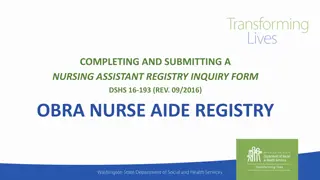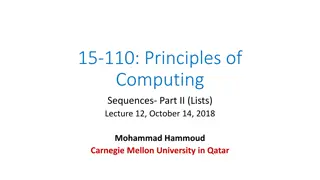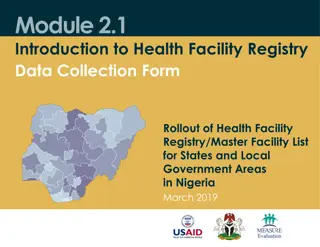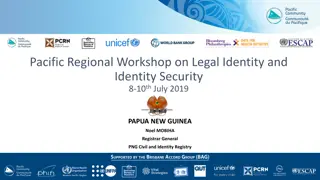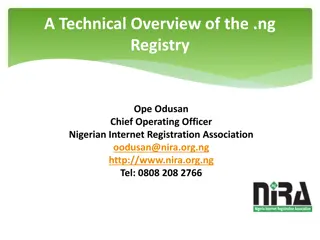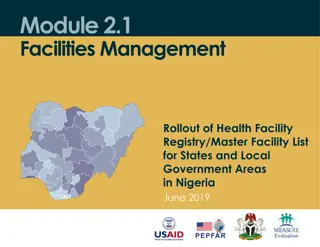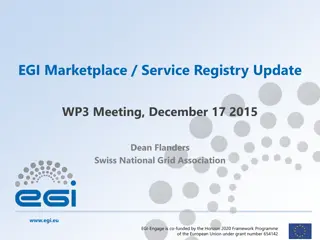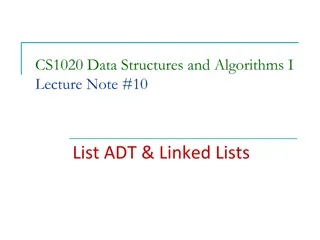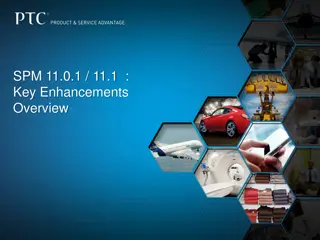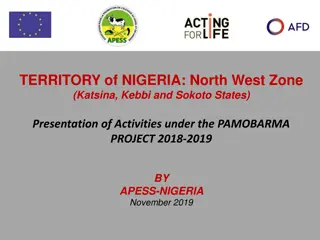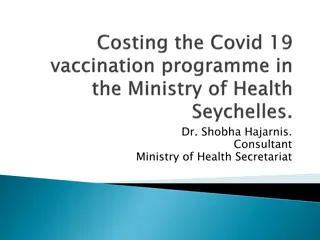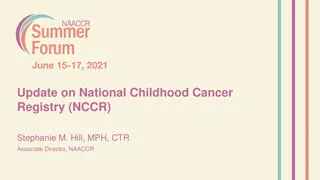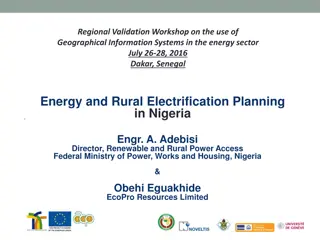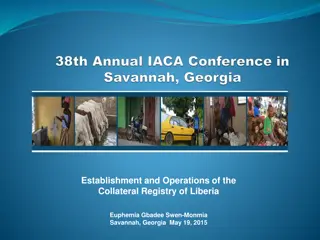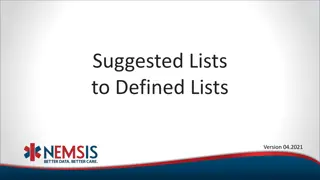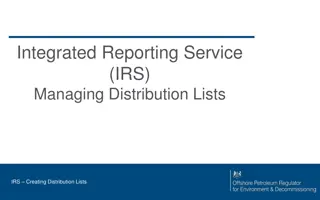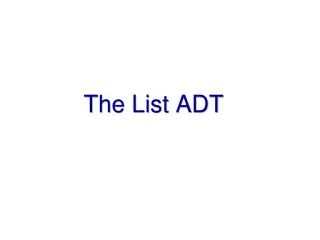Overview of Master Facility Lists in Nigeria: Rollout of Health Facility Registry
The document provides an overview of the master facility lists (MFLs) in Nigeria, focusing on the rollout of the Health Facility Registry (HFR) for states and local government areas. It discusses the elements of functional MFLs, the process of facility listing, HFR development, governance plans for rollout, and the importance of a governance structure for oversight and management. The background outlines previous initiatives, such as the establishment of a Technical Working Group (TWG) and the consolidation of various lists to create a comprehensive database. The content emphasizes the need for verified, updated, and accessible data to meet stakeholders' needs.
Download Presentation

Please find below an Image/Link to download the presentation.
The content on the website is provided AS IS for your information and personal use only. It may not be sold, licensed, or shared on other websites without obtaining consent from the author. Download presentation by click this link. If you encounter any issues during the download, it is possible that the publisher has removed the file from their server.
E N D
Presentation Transcript
Module 1.1 Overview of Master Facility Lists in Nigeria Rollout of Health Facility Registry/Master Facility List for States and Local Government Areas in Nigeria March 2019
Outline Introduction Background Elements of functional Master Facility Lists (MFLs) Process of facility listing Health Facility Registry (HFR) development Governance Plans for rollout
Introduction What is the MFL? What is the HFR? Master Facility List What is the difference? Comprehensive list of health facilities Unique identifiers Verified (last 2 years) Updated according to standard operating procedures (SOPs) Accessible to key stakeholders Health Facility Registry Database that houses the MFL Facilitates sharing interoperability Communicates with other systems
Introduction What else is needed? Governance structure Governance structure that provides oversight and management of the MFL To ensure the MFL and HFR meet the needs of stakeholders Master Facility List Comprehensive list of health facilities Unique identifiers Verified (last 2 years) Updated according to SOPs Accessible to key stakeholders Health Facility Registry Database that houses the MFL Facilitates sharing interoperability Communicates with other systems
Background In 2013, the Government of Nigeria (GON) published a list of health facilities. Few parameters were collected. Processes for continuous updating were missing. In 2016/2017, a new initiative with USAID support: MFL Technical Working Group (TWG) was established Specifications for online facility registry gathered Multiple lists were again compiled and validated In 2018, further USAID support: Development of SOP for HFR management Configuration of online database strengthened Integration of National Health Management Information System (NHMIS) with HFR MFL was aligned with District Health Information Software (DHIS 2) facility list Plans made to rollout facility registry to states
Consolidation of MFL 1. Stakeholders workshop 2. Harmonization of identified lists Called by Department of Health Planning, Research & Statistics (DHPRS) Aug. 2016 Stakeholders presented their HFR lists MFL TWG was formed 3. State-level draft MFL validation Protocol to merge the list developed 10 different lists were used 2013 MFL used as base list Draft MFL was produced 4. Additional list DHPRS sent draft MFL to states for validation Merged list of about 50,000 records was adopted 5. Data cleaning Data collectors were used Duplicates were cleaned Data collectors visited states for validation MFL with 39,550 records Additional HF lists were identified and retrieved 8 more lists were used Global positioning system (GPS) data were collected
Elements of functional MFL 1. Facility listing The list that describes all health facilities in a country Data covering predetermined facility attributes 2. Facility registry service A platform for storing, managing, and sharing MFL Enable data consumers to search, sort, and download MFL data Facilitate interoperability with other data systems 3. Governance structure Supportive policy environment Leadership to oversee establishment and management of MFL Integration of NHMIS with HFR SOPs for maintenance of MFL Resource allocation to support MFL
MFL/HFR development Facility listing Current, validated MFL that meets needs of data consumers MFL with gaps and data quality issues MFL continuously updated and validated Multiple facility lists Health facility registry Functional, up-to-date, shareable MFL Web-accessible service allowing data consumers to view and interact with data Service that is interoperable with other systems Spreadsheet with limited functions Text document Governance structure Strong Policies and standard operating procedures exist leadership and oversight for continued MFL maintenance No policy or leadership around MFL Stakeholder support for MFL Model adapted from https://www.who.int/healthinfo/country_monitoring_evaluation/mfl/en/
1,606 facilities in Abia 973 of these are public and 633 are private
HFR development System to manage facility lists has been developed and hosted in the cloud System is open to public; management of HFR has roles for the 3 tiers of governance in Nigeria The system is built to support facility registration process workflow HFR and DHIS 2 integration is ongoing; all updates in HFR will be sent to the DHIS 2
Governance (1) For sustained systems MFL Technical Working Group Broad range of stakeholders Motivated around common goal Development of monitoring and evaluation (M&E) framework Core group of Federal Ministry of Health (FMOH) DHPRS and ICT staff https://www.measureevaluation.org/resources/publications/fs-18-317
Governance (2) Policy environment SOPs Representatives from 17 states Described processes for facility creation, update, and closure Produced standard workflows that can be adapted to state
HFR rollout in Abia and Niger Jan April 2019 Strategy will actively engage state and local government area (LGA) authorities and include three phases: 1. Session 1 training (3 days) Train participants on the purpose of the MFL, data collection form, data quality, and use of GPS 2. Data collection LGA authorities will visit health facilities as needed to improve data quality of MFL 3. Session 2 training (3 days) Train participants on how to enter and validate health facilities in HFR
HFR rollout nationwide May September 2019 Leverage experience from Phase 1 in Abia and Niger Improve on training materials Improve on training methodology Train more trainers for countrywide rollout MFL TWG will continue to monitor MFL/HFR data quality for the states trained on how to use HFR, using the MFL/HFR M&E framework developed MFL TWG will coordinate rollout efforts across the other states and Federal Capital Territory in the future (post-MEASURE Evaluation)
Thank you To access the HFR, please visit https://hfr.health.gov.ng
This presentation was produced with the support of the United States Agency for International Development (USAID) under the terms of MEASURE Evaluation cooperative agreement AID-OAA-L-14-00004. MEASURE Evaluation is implemented by the Carolina Population Center, University of North Carolina at Chapel Hill in partnership with ICF International; John Snow, Inc.; Management Sciences for Health; Palladium; and Tulane University. Views expressed are not necessarily those of USAID or the United States government. www.measureevaluation.org




